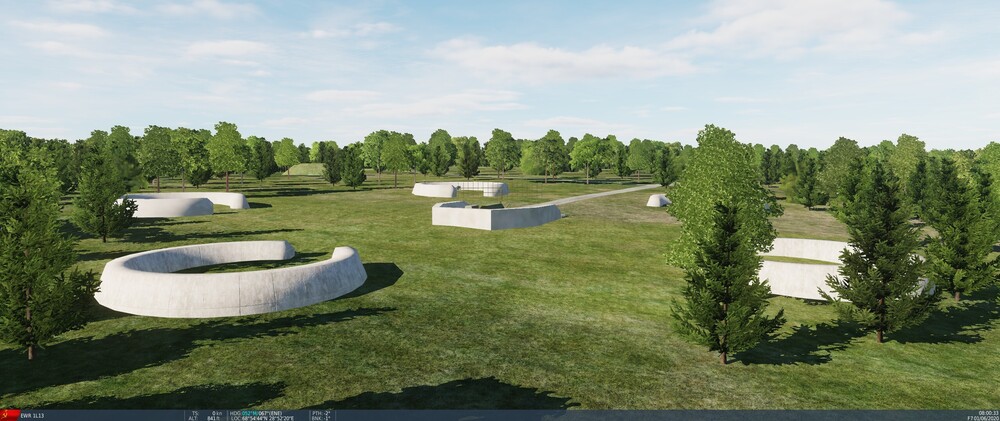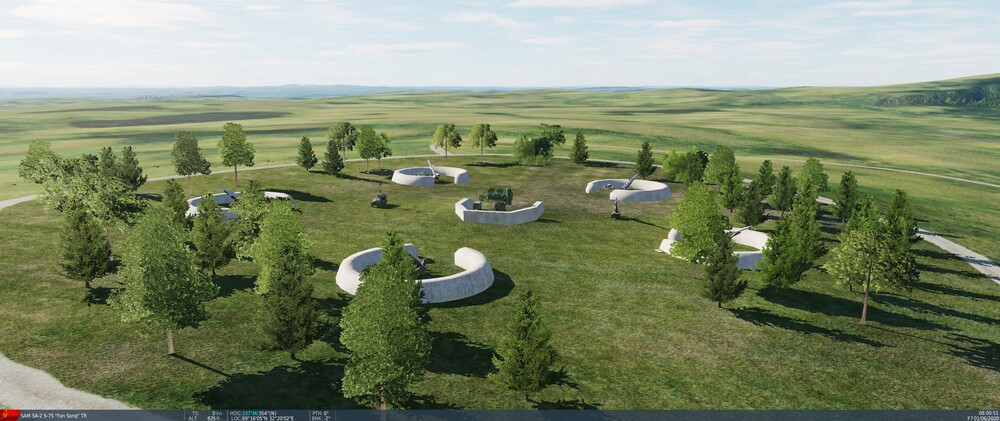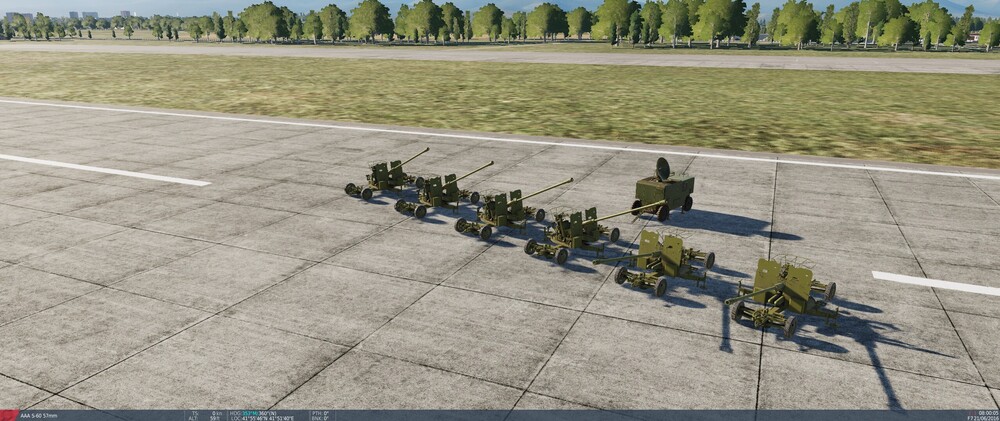

MBot
Members-
Posts
3938 -
Joined
-
Last visited
-
Days Won
19
Content Type
Profiles
Forums
Events
Everything posted by MBot
-
To me it seems that the cockpit engine sounds are not tuned in line with the rest of DCS. The Phantom is considerably louder than any other module I fly. When it was released, with my standard sound volume settings, I had at first difficulty to understand my teammates on discord and the high engine sound level started to actually hurt after a while. I had to re-tune my sound levels for the Phantom. While this was a short-term solution, it should not be necessary to re-tune my sound settings each time I fly a different aircraft. The Phantom sound volumes should be aligned with the rest of DCS. Here is a quick comparison. All aircraft with the same sound settings at full engine power. The Phantom is very loud.
-
I also have problems after the latest patch. After the first patch I could get the wheel to work correctly without using "VR mirror use system resolution", but the 2nd patch seems to have reverted this and now the UI (wheel and bomb table) is cut off to the side again with every other combination of options I use. I really don't want to use the "VR mirror use system resolution" option just because of the Phantom (with the VR mirror only using part of the screen, I can glance at various other useful things on my desktop through the nosegap of the headset). It was possible before the latest patch and I would like to keep it that way. Reverb G1 user here. That new UI is really a huge PITA to get to work correctly. Hours of poinless tinkering required so far. I dread the moment the F-14's cristal clear, precise and fast UI migrates to the new system...
-

fixed internally AI Bomb Armed Ships
MBot replied to MBot's topic in Aircraft AI Bugs (Non-Combined Arms)
Works with "No reaction", "Passive defense" and "Horizontal AAA fire evade". Doesn't work with "Evade fire", "Evasive vertical maneuver" and "Allow abort mission". I guess we can live with it, but I don't understand why it should inhibit attacking warships under everything less than "Allow abort mission". "Allow abort mission" should be the only option that, well, allows to abort the mission... -
I am just judging the track that was being provided. If you have an issue, you need to supply a track that is demonstrating it so others can reproduce it. Otherwise the chances that your issue can be resolved is next to zero. I am not saying you don't have a problem. But the track you provided is not demonstrating a problem.
-
I don't see a problem here. If I open your Phantom track and switch the aircraft from F-4E to F-5E (keeping the same route/speed), they are not engaged either. The problem is a terrain masked approach and not sufficient time for an engagement once the aircraft are unmasked. If I open the Phantom track and move the SA-2 site to a more suitable position, it engages just fine.
-
Sites are often on slopes with no proper fields of view, even if the site should clearly be on a hilltop (especially the EWR sites). Trees are placed right around the launcher revetments. SA-2 sites have revetments for just 5 instead of 6 launchers. EWR Sites: SA-2 Site: SA-3 Site:
-
I really hope the SAM/EWR sites are just a first rough draft. Because the effort looks extremely cheap.
-
Here: https://irp.fas.org/doddir/navy/strategy1980s.pdf I belief you will find this a most interesting lecture. The Navy was very much prepared to fight what they called a Global Conventional War.
-
I don't have the document available right now but will try to post it later. There is a very nice overview of the US Navy Maritime Strategy in the 80s (internal briefing for officials). The Navy wanted at least (the more the better) 3-4 carriers into the Norwegian Sea, 2-3 carriers into the Med, 0-1 to deal with the Soviet Indian Ocean Squadron and the rest of the available Pacific Fleet carriers (I think 6-7) in the Pacific. None were initially foreseen for Germany.
-
None of that is adressing Central Europe (i.e. Germany).
-
Of course you never know what would have happened under specific circumstances, but doctrinally the carriers had little to no role in central Europe. Naval aviation is really expensive (carriers, aircraft, training), so it doesn't make much sense to use it in places where you can also use cheaper land based aircraft. Unless of course there would be nothing better do to for the naval aviation, i.e. in limited post-Cold War conflicts. But during WWIII there would have been no shortage of tasks for the navy. The USN was expected to engage the Soviets and its allies on accross the globe and generally did not have the number of carriers it thought it needed to cover all commitments (Norwegian Sea, Mediterranian Sea, Pacific, Indian Ocean). So I don't see it supporting the initial defense of Germany. I could imagine that naval aviation would have been used to support a proposed amphibious landing of a Marine division on Jutland a little time into the war for the defense of Denmark. Or if things went really bad, to support a landing during a counter-offensive on occupied western Europe a couple weeks/months later.
-

AGM-45 Shrike Quick Guide by Klarsnow - updated June 5th 2024
MBot replied to HB_Painter's topic in DCS: F-4E Phantom
LOFT with ARM doesn't seem to be working. Shrikes are shot immediately when you press and hold pickle at the IP. -

AGM-45 Shrike Quick Guide by Klarsnow - updated June 5th 2024
MBot replied to HB_Painter's topic in DCS: F-4E Phantom
Well the problem is not that I can't get it to work. The question is rather if Shrike is better or worse than the other tactical options you have. I guess one specific use case is against tactical SAMs such as SA-8, where the launcher might be difficult to pick out amongst other nearby vehicles: Here a SA-8 was baited to reveal itself by provoking a launch. The enemy lock is defeated by terrain masking, which also resets the SAMs reaction timer (time to reacquire and preparing a launch). This gives a comfortable 30+ seconds window for a pop up attack. The SA-8 is struck by two Shrike which disable but fail to destroy it. The advantage of Shrike here is that you don't need to know which vehicle exactly is the SAM launcher. If the SAM is easily identifiable on the other hand (such as a SA-2/3/6 in typical formation), a Maverick is probably the better option as even a single missile will ensure a kill. -

AGM-45 Shrike Quick Guide by Klarsnow - updated June 5th 2024
MBot replied to HB_Painter's topic in DCS: F-4E Phantom
I feel similar. After having testing it for a while now, I fail to find the tactical use for the Shrike. At medium-high altitude it lacks the range to go head-to-head with radar SAMs. It requires terrain masking to close to the target. But when doing so, you might as well just perform a pop-up bombing attack with Rockeyes. This is reliably doable against contemporary radar SAM systems (30-60s reaction time) and much more effective than Shrike. Alternatively, Maverick offers a similar stand-off capability as Shrike while having a much higher kill-probability. Also it is not like Shrike could visually guide you to a SAM site of unknown location. With a boost phase of just 1 second or so there is no way to visually follow the missile to a target. -
Yes please remove the low flying question, or make it an option to disable it. I don't understand what purpose it serves and it gets super annoying. The other interesting thing with the fuel check is that it happens frequently on final or even during the flare. At first I thought it is just a coincidence. But it happens so frequently (while the chances should be so small) that it seems to be a systemic issue that trigger it.
-
The attached track features the following air-ground test scenario. 4-ship formation intending to attack a target in "one pass haul ass"-style attack. Straight-in, every aircraft in the formation attacking an individual target point simultaneously, straight-out. There are 4 setups from top to bottom: 1. Target is a group of 4 vehicles, CAS, task "Attack Group" 2. Target are 4 groups of 1 vehicle each, CAS, 4 times task "Attack Unit" 3. Target are 4 static objects, CAS, 4 times task "Attack Unit" 4. Target are 4 coordinates, Ground Attack, 4 times task "Bombing" (Task "Attack Map Object" is omitted, but would behave exactly like 4.) Watch the behavior in the track: 1. Only with the task "Attack Group" are all 4 aircraft in the formation able to attack an individual target simultaneously (where all targets need to be in the same group). For the tasks "Attack Unit", "Bombing" or "Attack Map Object", only the leader will attack the first target. Only when the first target is destroyed and thus the task is completed, will No. 2 attack the second target. When the second target is destroyed, No. 3 will attack the 3rd target etc. It is thus not possible to create for example a single-pass strike on an airbase where let's say one aircraft hits the runway, one the tower, one a hangar and one a fuel tank (at least not with the tools given in the ME, with scripting you can task individual aircraft). 2. Observe the absurd of amount of crazy maneuvering over the target area. A smooth "in, strike and out" this certainly is not. 3. Four AI aircraft crash in this most simple scenario. Before anyone mentions the option "Group Attack" in the taskings, this will simple cause all 4 aircraft in the group to simultaneously hit the same target. It is thus not suitable for targets with multiple elements. These problems are as old as DCS. So what, 16 years now? Since this seems to have been completely forgotten, I thought I would mention it once a decade. SimultaneousAttack.trk
- 1 reply
-
- 3
-

-
The attached track features a 4-ship in trail formation doing a simple 90° turn. Note the vast amount of unnecessary maneuvering, air brake and afterburner usage by number 4. This should be a very simple maneuver where each aircraft in the formation performs the same turn in sequence. This seems to be caused by a formation logic that mandates keeping a relative position to the previous aircraft at all time, which gets shifted considerably by maneuvering of the lead aircraft due to the pendulum effect (and being potentiated for subsequent aircraft in the formation). Overall this formation logic causes very inefficient and visibly erratic AI behaviour in any formation with tactical spacing. FormationKeeping.trk
-
- 2
-

-
Bump for Soviet EWR/GCI radar for the Kola map.
-

AGM-45 Shrike Quick Guide by Klarsnow - updated June 5th 2024
MBot replied to HB_Painter's topic in DCS: F-4E Phantom
I am sorry man, but primus_TR even bolded the answer to your question in his quote -

AAA group "simultaneously active units" appear to be limited to 4.
MBot replied to Aernov's topic in Mission Editor Bugs
Only up to 4 AAA units per group engage the same target at a given time. This should be increased to 6, as historically AAA batteries usually consisted of 6 guns. -
Nice effort. One thing to consider is also where the various lines are referenced in the aircraft. In The F-5E for example, the Fuselage Reference Line (from where AOA is measured) is 35 mils above the Zero Sight Line (from where the pipper is depressed, i.e. "0 mils"). So you always had to calculate mils depression from flight path + mils AOA - 35 mils. I don't know how how the reference lines in the F-4E are related to each other.
-
Yes, also the SA-6 Straight Flush has the same high pitched continuous tone for search and track mode, even though the search and the tracking radar are two separate systems (the search radar is rotating).
-
Oh I think I am doing just fine at 15° dive angles I think it is rather funny that you are lecturing with authority about the importance of AOA, considering when I brought up AOA a couple of days ago in the bug report thread it seemed by the answers of HB that no one had an idea what I was talking about Don't worry, I am just pulling your leg a little. I greatly appreciate that HB is engaging with people and trying to help. I am not saying that with Direct you are going to get pinpoint precision in operational conditions. That is why you drop a lot of bombs at once. But with proper planing, the right numbers and precise flying you can consistently drop individual bombs within lethal distance at the range.
-
Actually, G in an unloaded dive is a function of dive angle. In a 45° dive G would be 0.7, in a 90° dive it would be 0 etc. Also, G does not have an impact on bomb ballistics, therefore for a single bomb drop it is irrelevant. The bomb is accelerated by the G of the aircraft as long as it is attached to it. The instance it is released it is no longer being accelerated by the aircraft and will simple follow a ballistic trajectory from then on. G affects the spacing between ripple releases though. I am very opposed to this attitude Direct is as accurate as any other mode if fly the numbers (and these numbers are actually correct).
-
It's from here: https://apps.dtic.mil/sti/tr/pdf/ADA231546.pdf A pretty interesting read.








